#bible garden of eden location
Explore tagged Tumblr posts
Text
Vault-Tec Vaults; Game Origin & Location
Hi I'm going to back to my "Fallout Blog" roots. Here is a summary of all of the vaults and experiments (starting with a timeline) because I'm insane ^_^ I had to add a weird break bc I literally hit the tumblr character limit, but I used it to section off the major spoilers for the TV series :)
Timeline
The Great War: October 23rd, 2077
Fallout Bible: Compendium of added lore by the creators.
Fallout 76: 2102
Fallout 1: 2161
Fallout Tactics: 2197
Fallout: Brotherhood of Steel: 2208
Fallout 2: 2241
Fallout 3: 2277
Fallout: New Vegas: 2281
Fallout 4: 2287
Fallout TV Series: 2296
Corporate Vault - Fallout: Brotherhood of Steel - Texas
A control group vault meant for Vault-Tec employees to continue research, primarily on FEV (Forced Evolutionary Virus) during the war.
Vault 0 - Fallout Tactics - Colorado
A control group vault with geniuses kept in cryogenic stasis, with their minds interlinked into an entity called The Calculator.
Vault 3 - Fallout: New Vegas - Nevada
A control vault. Residents ended up opening the vault doors when the lower levels flooded. Eventually the vault was overrun by Fiends.
Vault 4 - Fallout TV series - California
A test vault that was filled with residents prior to the bombs dropping. Experimentation on human subjects led to most of the original residents being killed in a revolt. In 2296 the vault is still thriving, while kidnapping surface survivors and continuing to experiment on them. The vault offered refuge for many inhabitants of Shady Sands.
Vault 8 (Vault City) - Fallout 2 - Nevada
A control group vault that remained closed until 2241. Instead of receiving two G.E.C.K. (Garden of Eden Creation Kit) devices, Vault 8 received just one and a replacement water chip that was supposed to go to Vault 13.
Vault 11 - Fallout: New Vegas - Nevada
Every year the residents were told to sacrifice a fellow resident, with the threat of everyone's death if they did not. In reality, the system would praise them for NOT sacrificing an individual and the vault door would be unlocked. This message finally played after only five residents remained.
Vault 12 - Fallout 1 - California
A seemingly normal, safe vault with an ulterior motive to study the effects of radiation on the inhabitants. The door never fully sealed, and in 2083 the ghoul residents left to found Necropolis.
Vault 13 - Fallout 1 & Fallout 2- California
Your home vault as the Vault Dweller. A rather normal vault, however due to a shipping mishap Vault 13 received an additional G.E.C.K. device (that was supposed to go to Vault 8) instead of a replacement water chip. Thus, leaving the Vault Dweller to leave the vault in search for a replacement when their only water chip breaks.
Vault 15 - Fallout 1 & Fallout 2 - California
A vault that experimented with incredibly diverse ideologies and backgrounds. The vault became severely overpopulated in 2097 and the dwellers decided to open the door. Shady Sands was created using Vault 15's G.E.C.K. and the local raider gangs all have origins from this vault.
Vault 17 - Fallout: New Vegas - Mention Only
Inhabitants were kidnapped and transformed into Super Mutants. Lily originates from this vault.
Vault 19 - Fallout: New Vegas - Somewhere in CA/NV/AZ/UT
Paranoia was induced by noises, lights, and segregation. The vault was divided into two sections, Red and Blue, with a separate overseer for each sector.
Vault 21 - Fallout: New Vegas - Nevada
An almost normal vault, with the exception of a culture and society built around gambling. All major decisions were made through gambling, with the decision to open the doors and become part of New Vegas being "won" in a game of Blackjack.
Vault 22 - Fallout: New Vegas - Somewhere in CA/NV/AZ/UT
A vault dedicated to studying agriculture. A fungus designed to kill pests on plants became capable of infected human hosts. Vault 22 is curiously green on the outside by the time The Courier arrives at the location.
Vault 24 - Fallout: New Vegas - Mention Only
Remnants of a Vault 24 jumpsuit are found in the FNV game files.
Vault 27 - Fallout Bible - Mention Only
A vault designed to be deliberately overcrowded with not enough means to sustain the inhabitants.
Vault 29 - Fallout 76 - Mention Only
Only children younger than 15 were allowed in this vault, with their parents being sent to other vaults. Harold is believed to originate from this vault.
//TV SHOW SPOILERS//
Vault 31 - Fallout TV Series - California
Part of 3 interconnected vaults, serving as cryogenic home for the managers and higher ups of Vault-Tec.
Vault 32 - Fallout TV Series - California
Part of 3 interconnected vaults, serving as a healthy breeding pool for Vault 31 and 33. Somewhere around 2294, Vault 32 failed and the residents resorted to murder, cannibalism, or suicide.
Vault 33 - Fallout TV Series - California
Lucy MacLean's home vault. Part of 3 interconnected vaults, serving as a healthy breeding pool for Vault 31 and 32.
//END OF TV SHOW SPOILERS//
Vault 36 - Fallout Bible - Mention Only
The only food in this vault consisted of thin, watery gruel.
Vault 34 - Fallout: New Vegas - Somewhere in CA/NV/AZ/UT
The vault was purposefully overstocked with guns with the overseer being able to give/deny access to residents. This inevitably led to it's downfall, and those who revolted and raided the armory relocated above as The Boomers in 2231.
Vault 42 - Fallout Bible - Mention Only
No lightbulbs over 40W were provided.
Vault 43 - Fallout Bible - Mention Only
A vault containing 20 men, 10 women, and one panther.
Vault 51 - Fallout 76 - West Virginia
A vault with a supercomputer as the overseer. Interference from the computer led to most of the residents being murdered by other residents.
Vault 53 - Fallout Bible - Mention Only
Most equipment was designed to break down every few months in order to stress out inhabitants.
Vault 55 - Fallout Bible - Mention Only
No entertainment tapes were provided.
Vault 56 - Fallout Bible - Mention Only
The only entertainment tapes provided were of one terrible comedian.
Vault 63 - Fallout 76 - West Virginia
The inside of the vault remains sealed, with the outside door being all that is accessible to the player character. Other parts of the vault are revealed through cut content.
Vault 65 - Fallout 76 - Mention Only
Remnants of the vault remain in Fallout 76 cut content.
Vault 68 - Fallout Bible - Mention Only
The vault contained 999 men and 1 woman.
Vault 69 - Fallout Bible - Mention Only
The vault contained 999 women and 1 man.
Vault 75 - Fallout 4 - Massachusetts
A secret experimenting in refining human genetics through selective breeding, genetic modification, and hormonal treatments. The vault's concept was made by Stanislaus Braun.
Vault 76 - Fallout 76 - West Virginia
The home vault of the player character in 76. It was a control vault, set to open after 25 years. This is when the player character leaves the vault.
Vault 77 - Fallout 3 - Mention Only
Mentioned by slavers in Paradise Falls, this vault was rumored to only contain one man and a box of puppets.
Vault 79 - Fallout 76 - West Virginia
A vault dedicated to hoarding the country's gold reserves.
Vault 81 - Fallout 4 - Massachusetts
Designed to develop a cure for every possible sickness or ailment. Residents were unknowingly sprayed with diseases by nozzles hidden in their rooms. The first vault overseer had thought this to be cruel, cut off the scientists from the rest of the vault and cut the nozzles from spraying residents before the experiments could begin.
Vault 87 - Fallout 3 - Somewhere in VA/PA/MD
The original vault experiment for 87 was scrapped, and it became a research center for FEV, leaving the vault wildly radioactive and inhabited only by super mutants by the time you access it as the Lone Wanderer.
Vault 88 - Fallout 4 - Massachusetts
An unfinished vault inhabited by ghouls.
Vault 92 - Fallout 3 - Somewhere in VA/PA/MD
The best musicians were sent to this vault to "preserve musical talent", but truthfully residents were subjected to subliminal messages mixed into white noise. Eventually some of the musicians went into random, murderous, psychotic rages that led to the end of the experiment.
Vault 94 - Fallout 76 - West Virginia
A vault with non-violent faith-centric inhabitants. The vault opened one year later to search for survivors. The vault became overrun by wastelanders and raiders that destroyed their G.E.C.K. and their nuclear reactor. The vault was swarmed with radiation and is now overrun by mirelurks.
Vault 95 - Fallout 4 - Massachusetts
A vault designed to get people clean and sober. After a successful 5 years, a Vault-Tec agent brought out a hidden stash of drugs for other residents to find.
Vault 96 - Fallout 76 - West Virginia
A vault with a focus on agriculture, animals, genetics, and mutations. The original residents were killed in a failed escape attempt, and the vault was then used by West-Tek scientist Edgar Blackburn to continue research on FEV.
Vault 100 - Fallout 3 - Mention Only
Remnants of Vault 100 can be found in game files and cut content.
Vault 101 - Fallout 3 - Somewhere in VA/PA/MD
The home vault for the Lone Wanderer. This vault was meant to never open and Vault 101 did not receive a G.E.C.K. However, the overseer of the vault pretty quickly broke this rule and occasional survey teams were sent to the surface. Several residents of Megaton are the result of these survey teams. Daddy James found the vault after the birth of the Lone Wanderer and negotiated his doctoral services in exchange for shelter.
Vault 106 - Fallout 3 - Somewhere in VA/PA/MD
Psychoactive drugs slowly released into the air of Vault 106, causing the vault to be filled with psychotic survivors by the time the Lone Wanderer visits.
Vault 108 - Fallout 3 - Somewhere in VA/PA/MD
A slew of experiments occurred in this vault. The elected overseer was dying of cancer, the primary power supply of the vault was scheduled to fail after 20 years, the backup power supply would not be enough to power ALL of the vault, the vault was given three times the normal amount of weapons, and the vault was not given entertainment. With a majority of scientists, one of the inner experiments involved repeatedly cloning the same man... Gary.
Vault 111 - Fallout 4 - Massachusetts
Your home vault as the Sole Survivor. All residents were meant to unknowingly stay in cryostasis, with scientists overlooking them. However, conflicts arose among those unfrozen, leading to the vault door eventually being opened.
Vault 112 - Fallout 3 - Somewhere in VA/PA/MD
Residents lived in a virtual reality simulation to create their "perfect life" with their overseer, Stanislaus Braun, a scientist who proceeded to use the residents as playthings. Braun continuously murdered residents, then wiped their memories and reset the simulation.
Vault 114 - Fallout 4 - Massachusetts
An unfinished vault meant for only the wealthy. Vault-Tec exaggerated the luxury of the vault, gave residents very small rooms, communal bathing and dining areas, and a homeless drug-addicted overseer named Soup Can Harry.
Vault 118 - Fallout 4 - Maine
An Unfinished Vault meant to house both a handful of ultra-rich and hundreds of working class individuals to observe how they would interact within the same space.
Vault 120 - Fallout 4 & Fallout 76 - Mention Only
The vault itself was meant to mimic the underwater atmosphere of Bioshock. The game was cut from Fallout 4, but remnants can be found in Fallout 76 game files.
#fallout#fallout 1#fallout 2#fallout 3#fallout 4#fallout new vegas#fnv#fallout 76#fallout the series#fallout tv series#fallout tv#fallout amazon#fallout prime#bethesda#fallout lore#lore#brotherhood of steel#shady sands#sole survivor#vault dweller#lone wanderer#fo3#fallout nv#courier#vault 76#vault tec#fallout ghoul#fallout on prime
1K notes
·
View notes
Text
On today's "I am SO not normal about Dead Friend Forever": Discussing Catholicism and Colonization in this gay Thai slasher series
Some background on me: I am from a Latine Catholic family. Raised as a non-practicing Catholic (we didn't go to church or pray). Then my parents enrolled me in a Catholic school that I attended from 5th grade to the end of 7th grade. Today, I am not Catholic and have never really considered myself as such.
Ok, so in the flashback episodes of DFF, I have been noticing a lot of things. My findings under the cut.
Let's start with this crucifix and photo of the Virgin Mary and a baby Jesus.


Screenshot from ep. 5.
The camera lingers here a bit so we're obviously meant to pay attention to the phrase. I put the screenshot through Google translate's image translator and the translation it gave me was, "Think good, do good, be a good person." I didn't think much of it when I first watched the episode other than it was supposed to establish that the boys attend a Christian or Catholic school.
But then there was this image posted on Be On Cloud's Instagram (also from ep. 5): X

Zooming in, we can see there's another picture of Mary in the background. Watching the classroom scenes, it's easy to miss because the series itself is more washed out than the official photos posted. But this emphasis on Mary led me to believe the school is a Catholic one. So out of curiosity, I looked up the schools the writers and directors attended because I felt I was onto something here. And boy, was I!

Source: MDL
Ma-Deaw, if you didn't know, is one of the directors of Dead Friend Forever (he also directed Manner of Death and Inhuman Kiss , and lots of other things).
One Google search later (X) and I learned "Montfort College" is a Catholic school. It started out as a primary school that later added a secondary school as well.
Now let's take a closer look at some of the details of this school:
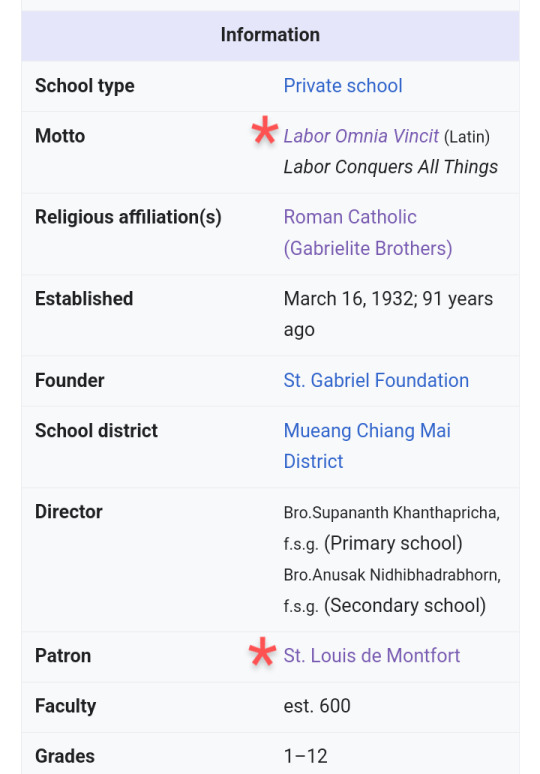
First, the school's motto "Labor Conquers All Things". This reminded me of the phone conversation Tee had with his uncle:

On my first watch, this sounded familiar to me but I couldn't really place why. It wasn't until I saw this other Tumblr post (X) that pointed out it's similar to a bible quote from the New Testament. The quote varies a bit depending on which version of the bible you're using but it's along the lines of, "He who does not work, neither shall he eat".
This is meant to discourage "laziness". Nevermind the fact that people deserve to eat simply because we get hungry and need food to survive. The idea that we only "deserve" things based on productivity is an extremely colonial one. — Reminder also that Tee is being forced into this "work" in the first place. He's just a high school kid. I don't need to like his character to understand how fucked up his situation is.
Then there's the patron of the school. St. Louis de Montfort was a French Catholic priest most known for his study in Mariology. What is Mariology (X)? The study of Mary, the mother of Jesus. I didn't know that was a thing but it's unsurprising considering how prominent images of Mary were in my own religious upbringing. And she's what started me down this rabbit hole in the first place. Mary is a big deal to the Catholics. I'm going to be paying even more attention now if more Mary imagery pops up.
The Garden of Eden and Original Sin
Now I want to draw attention to these images:


Screenshots from ep. 7
Here we have Non and Phee biting into an apple as they leisure around this lush green field. We know they've visited this location more than once because they're wearing different outfits in the screenshots. And I think it's important to note that it's Phee holding the apple and offering it to Non.

The use of the word "bait" in the bts of ep. 7 is quite interesting too. (X)
The Garden of Eden was the paradise in which Adam and Eve resided. In this garden, there were many trees to eat from. The one tree Adam and Eve were forbidden by God to eat from was the Tree of Knowledge. A serpent (Satan), first tempted Eve into taking from the tree to eat it's fruit. And then Eve gave the fruit to Adam. That is Original Sin. And because Adam and Eve ate from the Tree of Knowledge, all humans thereafter are born sinful and bad, and can only find salvation through God.
Of course in the scene between Phee and Non, the sin the apple represents is being gay. And it's after this, and after the bracelet scene, that Non becomes involved with Por's film and his tragedy begins.

Zoomed in screenshot from ep. 5
And I wonder if the bracelet scene is the last time Phee and Non visit this forest location. It would parallel how Adam and Eve were cast out of the Garden of Eden once they sinned.
Final Thoughts
You give me a story that criticizes Western religion and how it's used as a tool for oppression and colonization, and I'm gonna eat that shit up. I am gonna eat it up. Every. Single. Time.
I really wasn't expecting anything like this from Dead Friend Forever. This level in attention to detail is unmatched. I don't think I've watched a more well planned out show. And no matter where DFF goes from here, these seven episodes will always hold a special place in my heart. 💗
#dead friend forever#dff the series#pheenon#barcode tinnasit#ta nannakun#dff meta#dff spoilers#tabarcode#dff*#*#i just love it here#this is my comfort show idc
196 notes
·
View notes
Text
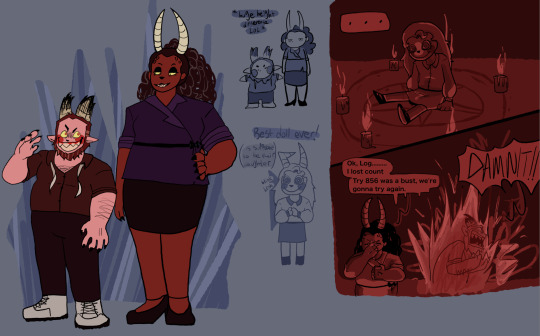
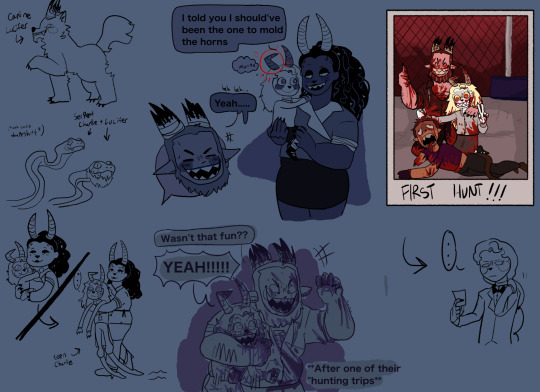


LUCIFER AND LILITH!!!! Here are my designs for them ( ꈍᴗꈍ)
So there's a LOT of changes I made for them, both in their designs AND their story/personalities that I won't go TOO into detail about here bc my next post is gonna be dedicated to their dynamic and their backstory and whatnot :)
BUT I WILL tell you that they actually MADE Charlie (like they literally molded a doll/child out of the elements of Hell and brought it to life with Satanic magic- she's like Pinocchio hahaha) so she was never a baby.
But that's also why her horns are crooked, one of her horns drooped when Lucifer was molding them (it was his fault LOL, he's sloppy)
Also Lilith -and by extension Adam and Eve- are Persian and African bc there are a lot of implications in the bible that the Garden of Eden was located in the middle east. AND also humans first evolved in Africa so I basically just combined real life evolution with Christianity to determine their races when they were human/alive
(I'll elaborate more in this in another post but those Hunting Trips you see w Lucifer and Charlie is especially just when Charlie was younger her and Lucifer would go out and torture/kill Sinners, a nice bonding time. I imagine that as Charlie got older, she realized that that was SUPER WRONG and stopped going out w him to do it- it caused a huge rift between them 🤐🤐)
AND CHARLIE DOES NOOOOOT HATE LUCIFER I PROMISE!!! THEY BOTH LOVE EACH OTHER BUT THEIR RELATIONSHIP IS JUST REALLY STRAINED........
AND ALSO in this rewrite, Lucifer is not in season 1 at ALL!!! Like, he'll be mentioned here and there but we do NOT see him in the first season. I just think that the writers relied on him way too much when it came to conflict (like his first appearance was in ep 5 and then he shows up to save the day in ep 8......... (and i DONT like how he was basically the only reason they won the war and how Charlie was able to get the meeting w Heaven in the first place, it feels like they took a lot of power away from Charlie, it was her problem, she shouldnt have had to call dAdDy to help her ykwim????)
#my art#hazbin hotel#lucifer morningstar#lilith morningstar#charlie morningstar#tw hazbin hotel#hazbin hotel redesign#lucilith#hazbin motel
122 notes
·
View notes
Text
As knowledge of the world grew, locating the Garden of Eden became problematic. Explorers and conquerors had traversed the whole world, and they hadn’t come across any magical gardens. But mapmakers still did their best, using obscure clues from the Bible to try to place the garden.
Most maps put Eden in modern-day Iraq, somewhere in the vicinity of Babel and the Tigris and Euphrates Rivers.
This map from 1700 gives the supposed location of paradise:

Just take a right at Babel, follow the wiggly river, and if you’ve hit the Persian Gulf, you’ve gone too far:

{Buy me a coffee} {WHF} {Medium} {Looking Through the Past}
Much more on Eden in maps and art here:
110 notes
·
View notes
Text
Things my Rewrite Will Fix About Descendants - Kingdom Names

I'VE DONE IT!!
Anyway, one thing (there are multiple though, let's be honest) that particularly irked me about the Descendants franchise would be the names of the kingdoms. While "Auradon" has a nice ring to it, some of the names of the other smaller kingdoms/locations leave something to be desired.
So for my rewrite series, Barriers (and for my second rewrite WIP that has yet to be named), I decided to rename the ones I didn't like.
Charmington -> Edenwald, Snow White and Florian's Kingdom

First of all, if any of the kingdoms were going to be named "Charmington", why wouldn't it be the kingdom from Cinderella? Originally, I wanted to swap Charmington for Cinderellasburg, so naturally, the old Charmington would need a new name. I wanted the name of the kingdom to reference the Enchanted Forest in Snow White, so Eden was the first name to come to mind (meaning paradise, but also referencing the Garden of Eden in the story of Adam and Eve from the Bible, which also parallels well to Snow White being the first Disney Princess). But "Eden" felt somewhat incomplete. Eventually, adding the "wald" (meaning forest in German, which is where the story of Snow White originates) at the end gave it a much more fitting name imo.
Cinderellasburg -> Charmont, Kit/Charles/Henry/Christopher and Cinderella's Kingdom

Don't get me wrong, I love Cinderella (somehow even more now than I did before), but why would they name a region after some commoner? Yes, her story's inspiring, but not inspiring enough to rename a kingdom in her honor. Having the kingdom named "Charmington", where the Charmings rule felt fitting at first. But, the more I looked at "Charmington", the more "Charmington" felt like a clothing store or a medieval amusement park. I wanted to incorporate "Charm" as a prefix , and took the suffix from "argent" (meaning silver in French, which is the color of Cinderella's dress) and changed the e to an o.
Auroria -> Aetheria, Aurora and Phillip's Kingdom

I almost left "Auroria" alone because it sounds so pretty and ethereal and whimsical. I could believe that either Aurora was named after "Auroria" or "Auroria" was named after Aurora and I was willing to let that be that. All I did was add ia to aether, and that sounded prettier to me lmao.
Auradon -> Beaumier, Adam and Belle's Kingdom

This one is specifically for my second rewrite. In this fic verse, all of the united kingdoms are still called "The United Kingdoms of Auradon". However, Adam and Belle are not the monarchs ruling over all the other kingdoms, therefore their specific kingdom needs a name. I wanted the name to be French inspired, and the name "Beau" felt fitting given it means "beautiful" or "handsome" like "Belle". "Beau" is also a nice little callback to the writer of the original fairytale in 1756, Jeanne-Marie Leprince de Beaumont AND to one of the villages the setting is based on, Ribeauvillé. All I did after that was research names of places that had "Beau" in the name, and I came across Beaumier Hotels.
And nothing for Seaside, because A.) All of the other names I came up with sound too corny (and I don't like Tirulia) and B.) Seaside's growing on me.
#disney descendants#descendants rewrite#my fic series: barriers#auradon#cinderellasburg#charmington#auroria#for future reference#things my rewrite will fix about descendants
62 notes
·
View notes
Text
Eden’s location in my AU
Rewrite is NOT canon friendly or Vivziepop friendly!
(There’s a lot under the cut so strap in)
So where is Eden? There’s a couple options.
No one location for Eden has been accepted by scholars throughout history. Though one general area is common. This area comes from Genesis 2:8 which is standardized to roughly say “Now the Lord God had planted a garden in the east, in Eden; and there he put the man he had formed.”
This East is commonly interpreted to mean what we in the modern day would refer to as The Middle East. For the sake of clarity I’ll be using this fairly limited area to classify the Middle East.

So where in this area is Eden?
Located between the Tigris and Euphrates rivers today. Except it’s also NOT located there.
Why between the Tigris and Euphrates? Genesis 2:10-14. As before I’ll use the scripture from the New International Version of The Bible for easy clarity, “A river watering the garden flowed from Eden; from there it was separated into four headwaters. The name of the first is the Pishon; it winds through the entire land of Havilah, where there is gold. (The gold of that land is good; aromatic resin[a] and onyx are also there.) The name of the second river is the Gihon; it winds through the entire land of Cush.[b] The name of the third river is the Tigris; it runs along the east side of Ashur. And the fourth river is the Euphrates.”
That’s a lot! Let’s interpret it. There are four rivers that flow from the same source. And these rivers frame Eden.
So what happened to the Pishon and Gihon rivers? Well some religious scholars suggested that after the Flood (Noah’s Flood) the land was so drastically reshaped that Eden’s location is impossible to find.
During medieval times it was suggested by the rabbi Rashi that the Pishon is actually the Nile. However during this same period it was suggested that it was the Ganges river instead. Other theories suggested that the Pishon and Gihon were streams that flowed from mountains.
Some people believe the Garden would’ve sat on the Fertile Crescent which lies in this general area.
So let’s rule some things out. The Ganges river is outside of the search area I set as it’s in modern day India. The Nile however could work. The only issue with this and the mountain stream answers is that before we decided that all of the rivers must flow from the same source. These rivers do not.
With this in mind I think it’s time to revisit something I mentioned earlier. The idea that the land was drastically changed after The Flood and throughout time. Looking at the map of the area between the Euphrates & Tigris and the Nile we can see several bodies of water that are separated by thin slices of land. It wouldn’t be too hard to assume that the passage of time and actions of God could have separate what is now The Red Sea, The Arabian Sea and the Mediterranean Sea into different bodies of water when they used to connected.
Thus I think the space between all of them should count as our current Eden space, however we still need to narrow this area down to map out what area of Eden is which.
Thus let’s turn to another common idea. The idea that Eden lines up with one of the earliest civilizations of Ancient Mesopotamia. This works well as it’s still in line with our search area and it would make sense historically.
From a science perspective all humans are said to originate from a point in Africa. That means to me that some part of Eden should be in Africa. And what do you know? The Nile (which we’ve decided will serve as our Pishon) is located in Egypt and Egypt in Africa.
Now should all of Mesopotamia be used or just certain fragments? Well I think that this outline of Mesopotamia works quite well.

Based off all of our criteria so far this map of what would be counted as Eden fits perfectly and thus I believe the Garden would roughly end up here. It 1) Contains the Fertile Crescent. 2) Touches the Nile and into Africa. 3) Contains both the Tigris and Euphrates and the first recorded civilization of man (Mesopotamia) where Adam and Eve would have created and lived in post exile. 4) Fits within outlined search area.
So therefore that image is where our Eden is going to be. Give or take a couple inches on the actual outline as I believe it to be a little restricting with certain areas.
You may noticed I have been avoiding talking about Cush and the Gihon. To be honest this is because I have struggled to place it but I think I have found a solution.
The Gihon and Pishon are the same river. They are both the Nile.
Before you attack me let me explain. The Nile is known as more than just one river. It is split into the Blue Nile and White Nile.
This is because the flow of water changes between these two points. The reason I believe there both are from the Nile is because Cush the area the Gihon is said to flow around can be translated to mean Ethiopia. And what river flows into Ethiopia? The Blue Nile.
This also fits with the requirement that all rivers flow from the same source. Thus the Gihon is the Blue Nile and the Pishon is the White Nile.
This does mean that Eden is extended further into Africa to reach Ethiopia but I have no problem with this interpretation as I find it fitting to reach into the scientific origin of man.
Eden’s Layout
The area in between the Tigris and Euphrates is Ashur as it matches the location of the real world city Assur and matches the description of Genesis 2:10-14.
Havilah is the area of Eden located around the Nile (Pishon) and Egypt/Africa. (Once again to match Genesis 2:10-14).
Cush is Ethiopia. For the reasons listed above in the White & Blue Nile explanation.
Eden Post Sin
You might’ve noticed one big problem with my placement. I’ve said I think Mesopotamia to be what the first descendants of Adam & Eve to have made in terms of society and where the two lovers would’ve lived post exile from Eden. However it takes up the space of Eden.
So how can they be in Eden post exile? Well the banishment from Eden in my AU is less the displacement of mankind and more the banishment of the Garden itself. The perfect inhabitable place withers and dies and becomes desert and sin upon mankind’s betrayal which is why ultimately Eden will never be found. As even if you stood where The Garden of God once was, man will never return to Eden again.
AU Masterpost
#eden#garden of eden#garden of god#helluva boss rewrite#hazbin hotel rewrite#hazbin hotel#helluva boss#vivziepop critical#middle east#mesopotamia#bible verse
9 notes
·
View notes
Photo

Garden of Eden
The Garden of Eden is the biblical earthly paradise created by God to be inhabited by his first human creation - Adam and Eve. Some claim that the name “Eden” derives from the Akkadian term edinu, which means 'plain'. In the biblical tradition, the garden is often alluded to by the biblical authors as a luxuriant place, which is why it is sometimes called the “Garden of God.” However, it is the biblical definition of the garden that is our concern here. Adam was the first man created by God in his image. After God saw the loneliness of Adam as "not good," God caused a deep sleep on Adam and created Eve (the first woman) out of Adam's rib as his helper (Genesis 2:20-23). To properly understand what the garden is to the narrator of Genesis, it is important to discern its location, the characters playing roles in it and what took place in it. All these contribute to our understanding of the biblical definition of the “Garden of Eden.”
The Eden narrative is narrated in the Bible's book of Genesis 2:4b-3: 24, which places the garden at the east side of Eden. Commonly, translations have the “Garden of Eden” with the construct element “of,” but the Hebrew text has 'gan-beeden', which is not in the construct form, and that the preposition ��be” in 'beeden' is to be translated as “in.” Therefore, it is grammatically incorrect to translate 'gan-beeden' as “Garden of Eden,” but the “Garden in Eden.” The actual location of Eden is disputed amongst scholars, but a number of them have concluded that the garden is an extraterrestrial place – where the gods resided. The water from the garden was the water-source for the two great rivers: Tigris and Euphrates, which are well-known in ancient Mesopotamia for the production of irrigation systems in the surrounding area. Its location then should be placed somewhere in Mesopotamia.
Location & Features
The description of the garden in Genesis 2:10-14 states that the water from Eden watered four important areas: Pishon, which flows into the land of Havilah; Gihon, which flows into the land of Cush; Tigris, which flows into the eastern side of Assyria; and the fourth is Euphrates. The garden is also said to have “every tree that is pleasant to the sight and good for food.” Yet, two trees are singled out: the “Tree of Life” in the middle of the garden and the “Tree of Knowledge of good and evil.” However, the Genesis account is inconsistent at some point, Genesis 2:8-9; 3:1-3 has both trees in the midst of the garden, whereas Genesis 3:22-24 gives the possibility that both trees were planted on the east side of the garden where Adam was originally placed.
Even more, the description of the garden in the Genesis account is not identical with other biblical texts alluding to the garden. For example, in Ezekiel 28, the luxuriant materials found in the garden are not mentioned in Genesis 2:4b-3:24. For some of these reasons, the concept of a “garden” of a god(s) was a very common metaphor in the ancient Near East of where the god(s) resided. For the narrator of Genesis, the “Garden in Eden” was imaginatively constructed for an etiological (origin or cause of things) purpose, not as a divine residence, but of the first man and woman on earth – Adam and Eve. As generally accepted in modern scholarship, Genesis 1-11 is labeled as the “Primeval History,” which includes mythologies and legends that were very common not just in Israel, but throughout the ancient Near East. These myths and legends are not Israelite in origin but were adapted by the biblical writers for either polemical or rhetorical purposes.
Some of the crucial questions readers ought to ask to properly discern the “Garden in Eden” are: What is the purpose of the Eden narrative in the book of Genesis? What did the narrator seek to achieve? Importantly, to reach this goal, readers should not treat the “Garden in Eden” exclusively from the characters playing roles in the narrative, such as God, Adam, Eve, the serpent, the singled out trees: tree of life and the tree of knowledge of good and evil, and especially the narrator's overall purpose. To focus exclusively on the "garden" without acknowledging these characters would only disrupt the plot of the narrative.
Continue reading...
29 notes
·
View notes
Text
The theory of Lesley and Maud (the first part)

1.Lesley. Is Lesley the prototype or spirit of the Tigris River? The Tigris River is one of the most famous and significant in the world. It flows through several countries in the Middle East. The Tigris and Euphrates are biblical rivers. From the Bible, you can learn that the Garden of Eden was located between the Tigris and Euphrates. The Tigris River (from ancient Sumerian - fast water) had a fast flow, unlike the Euphrates - a smooth flow. For this reason, the Tigris River was of great importance in ancient times in terms of transport and trade. What is not an international means of communication, like the company Lesley works for?
2.Maud. How can the Maud be conceptually related to the Tigris River? Matelda (abbreviated Maud) is a character in Dante's Divine Comedy. Dante meets her when he visits the Garden of Eden. She stands near the Lethe River and collects flowers. Moreover, in some texts it is found that the Tigris and Euphrates rivers flowed inside the Garden of Eden and were respectively the rivers of Lethe and Eunoe. Matelda acts as a mentor, she knows the answers to many questions and encourages Dante to ask her questions. Secondly, she is a priestess, she offers the soul to drink water first from the Lethe and then Eunoe (repentance and healing).
3.Symbols and hints. On the bedside table of the Maud are: -the apple (of Eden) -nightingale (symbol of love) -a glass of water (what Matelda brings to the souls in the garden) -books and glasses (symbol of knowledge) -flowers on the bed linen (like Dante, we first meet her near the Tiger and in flowers) -the painting on the wall (it is poorly visible, but obviously has African or Oriental motifs)
4.Another divine couple. There is a huge mirror opposite the bed, behind which there is darkness and no wall. I assume, Lesley and Maud are the prototypes not only of the Tiger and Matelda, but also of the Nile River and the goddess Maat. The Nile River is consonant with the name Neil Gaiman. Maat is the egyptian goddess of justice and divine law (about this and not only in more detail in the second part). Here I will once again mark the books on the bedside table. The bottom book is blue like a river. And on top there is a red and white book. Maat is often depicted in red and white clothes.
21 notes
·
View notes
Text
The Garden of Eden 🌱 The Real Adam & Eve Story

Official Pyramid Media 369 website: www.pyramidmedia369.com
IG: @Phoenix.Son | @PyramidMedia369
I have often heard others say, "If it's not in the Bible, it's not true". Which is a huge mistake and error of consciousness. This type of blind faith can lead to spiritual deprivation. Liberation and education is our birthright. So, I will provide proof of my claims, as well as break down the certain characters, locations, and events as needed. If you have any questions, send them via email at [email protected].
Why do we know nothing about the Serpent?
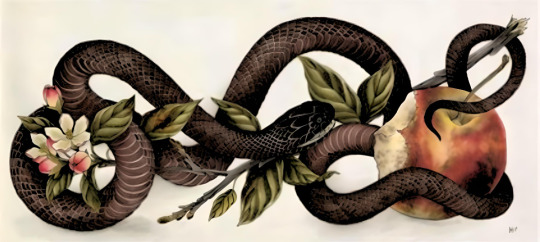
The only story we know of the serpent is how it convinced Eve to eat the apple on the forbidden fruit tree. But what's the Serpent's backstory? What relationship did God of the Bible have with the Serpent before Adam and Eve were ever thought of?
There are many creation stories. Some older than others. But the oldest stories seemingly have more evidence and artifacts to support their claims. Like the hieroglyphs in the pyramids for example. They literally are passing down knowledge through drawings, showing us what was really happening. Tablets like what you see below are ages older than the English language itself.
There is lots of information you can find out there about how human DNA was constructed, when it was, where and also who did it. However, there is only one pantheon I have found that has an illustrated story about the creation of human beings. The pantheon I'm referring to are the Annunaki aka Sumerians. The creator of modern day human DNA is Enki.
The eldest Annunaki/Sumerians are the Elohim that traveled here from Nibiru, a planet from the Sirius star system. These are also the Nephillim giants.

Enki - The Serpent God of Sumeria

Enki (EA) was responsible for the creation of the first modern day human. The tablets below show Enki and his son, Ningishzida, grafting the genetic structure of DNA which was used to create Adam. Enki and his counterpart, Ninmah, used this DNA to create Adam with the use of homo-erectus DNA, their own and clay from the Earth; making the first homo-sapiens (us). Earth was home to the homo-erectus before the Annunaki discovered Earth. The first homo-sapiens were heavily melanated. Below you can see that they used the sacred knowledge of the Tree of Life to create human DNA.
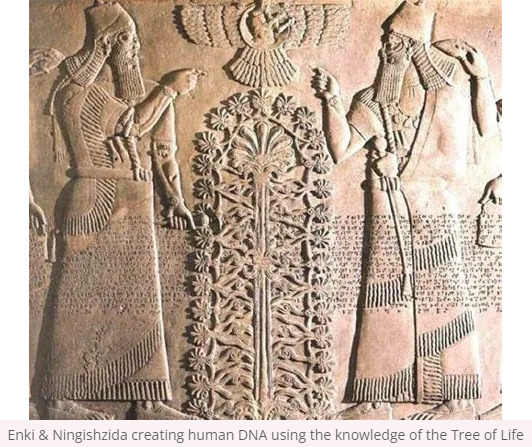
Enki & Ninmah creating Adam
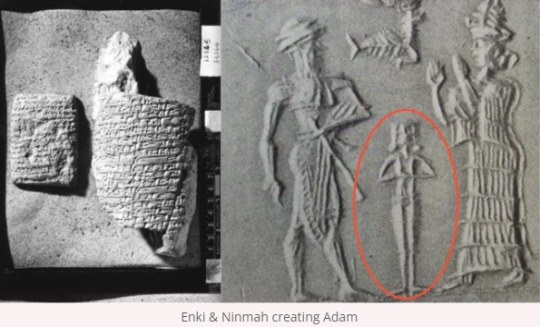
Above you see tablets with the written story vouching for the illustration of Enki and Ninmah creating Adam. Above Adam, you will also see a fish. Enki resides in the ocean below the Earth according to the tablets. This is synonymous to Enki being also the God of Water. Consider the fact that the human body is 70% made of water.
The Q&A below is based on an evaluation of historical facts that are relative to both the Sumerian tablets and the Bible story.
Q: What relationship did the God of the Bible have with the Serpent before Adam and Eve?
A: They're brothers.
Q: Who is Enki's brother?
A: Enlil, The God of Air
Q: How did this become the Bible story?
A: In the Sumerian tablets, Enlil stated, "You shall have no gods before me". This was also stated by God in the Bible, in Exodus 20:3.
Enlil - The Sky God of Sumeria

Enlil (YHVH/JEHOVAH) was the Chief deity on of the Annunaki on Earth, but very known to have a malevolent nature. Tyrannic, jealous and quite violent. He always claimed to be God over all things, due to his father, Anu, leaving Enlil in charge once they discovered Earth from planet Nibiru. Enlil did not support Enki teaching the humans sacred knowledge beyond being a slave-worker. It was Enlil's command that it should not happen. Enki went behind Enlil and secretly instilled in Adam & Eve the ability to procreate, which also gave them Kundalini (the coiling serpent); ultimately giving them self awareness. This is synonymous to the apple that was bitten from the Tree of Life. (Remember, Enki and Ningishzida used the knowledge of the Tree of Life to create Adam & Eve's DNA. Adam & Eve were not the first creations, but the first perfected creations). This self awareness gave Adam & Eve knowledge of Good & Evil. Meaning, both hemisphere's of the torus field (the apple) emanating from the body were now active.
The Torus Field & The Apple

Enlil waged a war on Enki's plans to teach the human beings how to sustain themselves and raise their consciousness through their own self awareness. So Enlil decided to overthrow Enki's creations by killing off as many as he could with the intent to free the humans from bondage. This is how Enlil became the one God. Enlil was appointed as leader of the Annunaki by Enki & Enlil's Father, Anu. Leading to Enlil being labeled as Lord over all. It was Enlil who orchestrated the great flood to kill off the human creations. Enki was not successful in preventing this from happening. With Enlil becoming Lord, the Serpent's role became demonized because it was forbidden by Enlil's command, though Adam & Eve were not his creations. Us humans today, are the remnants and descendants of those that survived this flood.
Enlil created and introduced us to the first weapons on Earth.

It's safe to say that the human creation was an experiment, to say the least. The Serpent only represented wisdom at a point in time. Why do you think this changed?
TO BE CONTINUED...
Check out this article if you would like to learn more about the connection between the Atom and the Flower of Life.
"Ancient Origins of The Flower of Life"
The Tree of Life is the original knowledge of the Flower of Life, which is the knowledge of the Atom, which is the knowledge of Carbon. All of which make up the 666: 6 protons, 6 neutrons, and 6 electrons that make Carbon, which is also Melanin. So this means an Atom is simply a Carbon molecule, which is also a Melanin molecule. Isn't that interesting? Or do you not see the connections? Let me know!
*AS ABOVE, SO BELOW*
Thank you for reading!
Fun Fact: Did you know, that an atom is the only molecule that can occupy two different places at once? There's always more than what meets the eye!
#Ancient#Sumerian#Annunaki#AnnunakiHistory#Enki#Enlil#Ea#Gnostic#Gnosticism#Pyramid#Media#369#PyramidMedia369#Blog#Esoteric#Astrology#Egypt#Adam#Eve#Garden#Of#Eden#GardenOfEden#Mesopotamia#Mankind#Spirituality#Evolution#Earth#Nibiru#Sirius
32 notes
·
View notes
Text
Giftedverse: Mars
Mars is the main setting of the Giftedverse. It is the home of the Gifteds after being exiled from Earth.
History
In the 60s and 70s, with the population of Gifteds growing and the emergence of the First Heroes, fear spread that humanity's superpowered counterparts were going to take over the world and enslave humanity, leading to massive outcry. Tensions rose, leading to several riots and killings of Gifteds.
The First Heroes faced immense backlash and scrutiny, often being met with protest and threats of violence towards themselves and their families during missions.
The Justice Bureau joined forces with NASA for a top secret project concerning the planet Mars. Over the years, secret construction of several cities on the planet started. One of the first cities built was Eden, named after the paradise garden in the Bible.
By the time the 80s came around, the project was mostly complete. All that was left was to make Mars liveable. To do this, they recruited Susanoo, one of the First Heroes, to reshape the entirety of Mars' climate using his powerful Gift.
Once that was done, the Justice Bureau began rounding up the Gifteds as the first inhabitants of the newly terraformed Mars. Thinking they would be living on Mars side by side with humanity, the Gifteds embraced their new life and settled down. As the years went on, they began to realize the truth: they'd been relocated to Mars permanently and were never going to be able to go back to Earth or leave.
Effectively abandoned and left to fend for themselves, the Gifteds brought the cultures from their former homes on Earth and used it to create one unique to their new home.
Over the years, however, heroes became popular among Humans and the demand for them increased. Along with that came some people advocating the return of Gifteds. But the Justice Bureau didn't want the Gifteds back on Earth. But seeing an opportunity, the organization built teleporters to quickly transfer Heroes to Earth solely for missions. Once the mission was accomplished, they'd be automatically sent back to Mars.
Heroes are allowed to operate on Mars but only under the supervision the Martian Police Force (MPF). Because of that, the Heroes decided to retain their civilian identities and get civilian jobs due to the reputation of the MPF.
Locations
Eden: Capital of Mars and largest city. Named the garden from the Bible, it is considered by many to be the cradle of life for Martians. It is home to many important buildings including the Hero's Honor Center, The First Heroes Memorial, and the Templar Training Academy.
Romulus: 2nd largest city, named after one of the twin sons the Roman god Mars. It is a hub for entertainment, the arts, and culture.
Remus: Romulus's twin city, thus making it the 3rd largest city on Mars. A hub for business, commerce, and economics.
Mount Ibaraki: Home of the Yamaniwa clan. Named after the prefecture Mother Nature was born in back on Earth.
4 notes
·
View notes
Text
After the phantom stranger and destiny have been living with madame xanadu for a few months, destiny finally remembers something that could serve them as a good clue on the hunt for their true origins. Years ago (when stuck in his house at the edge of the known universe), destiny met three other weird cursed souls: Cain, Abel and Eve. These three could probably help destiny and the phantom stranger discover their real origins, but god has wiped any and all knowledge as to their location from destiny's mind. So they're stuck in between a rock and hard place here.
Thankfully, the team eventually runs into Blue Devil when they're on a mission in California, and he happens to know Cain pretty well. So, Blue Devil acts as their guide, trying to help them find the house of mystery and the house of secrets and however many other houses there are. It's a hard job (because the location of these houses is constantly shifting), but after a few months of searching, they finally find the places. And destiny and the phantom stranger finally get to ask cain, abel and eve all the questions they wanted to ask them.
What we then get is my heavily critical takes on the abrahamic myths of the garden of eden, adam and eve and cain and abel. To go into more specific detail, let me break this into two or three separate parts:
The Story of the Garden of Eden (and of Adam and Eve): The garden of eden was the abrahamic god's private garden, where he only allowed himself to dwell. All other gods and mortals were excluded, because he was a jerk who wanted to keep his paradise to himself. But eventually, god decided to try letting humans in his home. So he took two mortals in ancient times (a man named adam and a woman named eve) and he invited them to live in his garden with him.
He lorded himself over them, trying to make them obey his every whim. He barely fed them, he gave them no home, no clothes, he only told them to get to making children for his garden to flourish. So naturally, one of god's servants (one "angel" by the name of lucifer) saw what he was doing as inhumane, and he tried to help Adam and Eve. He appeared to then as a snake, and he led them to partake of the apples of knowledge, which gave Adam and Eve perfect knowledge of the cosmos. Using this knowledge, they realized how stupid they were to come to this garden, and they tried to flee with lucifer.
But God caught them, and he was most displeased. Paranoid that they would try to coup him and steal his garden with their new knowledge, this power mad lunatic cursed the three of them to suffer for all eternity. His punishments were all way too cruel and unusual for the crime: He killed Adam and trapped his spirit in the form of a raven; he cursed Eve with immortality and trapped her in the frail body of an old crone, and he trapped Lucifer in a coffin buried deep underneath his garden. Lucifer is still stuck there, and he will be until someone finally frees him from his centuries of torment.
But if you didn't figure it out yet, Eve and her pet raven are actually the Adam and Eve from the Bible. Eve was cursed and became the old witch of the DC mystery comics, and Adam was killed (and what little remained of his soul reincarnated as Eve's pet raven). As mentioned, Lucifer is still suffering. So perhaps we'll revisit that in a later story with the justice league dark or something. But that's the story behind Eve's curse.
The Story of Cain and Abel: Cain and Abel were humble farmers in ancient times, two brothers with happy lives and families. But naturally, the abrahamic god entered the picture and messed everything up for both of them. Because he stumbled upon them one day, and he played favourites deviously.
He lavished riches and prosperity onto Abel and his family, and then he cursed Cain's family with constant misfortune. Cain's crops died, his infant son died in a flood, his wife died of the plague, etc. So while Abel and his wife lived the high life, Cain was being driven to madness by a cruel and callous god. Indeed, Insanity is where Cain eventually lands. After Cain's second child dies of starvation, he finally snaps.
Bitter that Abel lived a life of luxury while he got nothing, Cain sneaks into Abel's home and kills him in cold blood. In his eyes, he's righting the scales. Of course, Cain feels horrible after killing his brother. When his sanity finally returns to him, Cain uses the last of his energy to kill himself too. Two brothers lay in a pool of blood, dying because of an evil god's machinations.
But god wasn't done with them. He cursed Cain and Abel to guard the House of Mystery and House of Secrets for eternity. They would be forever distant from the world of man, as punishment for "their cruel acts of violence and egotism". Nevermind the fact that the same god punishing them is the one who made them kill each other. But that's the story of why Cain and Abel are cursed.
So Cain, Abel and Eve share their stories with Destiny and The Phantom Stranger. From here, the stranger and destiny realize the easiest way to get vengeance on god might be to break into his garden and free lucifer. But to do that, they're going to need the aid of the entire justice league dark (if not most of dc's supernatural community).
#i could have sworn i posted all of this#but apparently i never did#so i have to post it now#the phantom stranger#phantom stranger#destiny#destiny dc#madame xanadu#blue devil#dan cassidy#cain dc#dc cain#dc abel#house of mystery#house of secrets#justice league dark#jld#dc#dc comics#dc universe#dcu#my ideas#dc ideas#comics ideas#story ideas#dc headcanons#dc headcanon
2 notes
·
View notes
Text

Where Was the Garden of Eden Located? by Ken Ham
Most Bible commentaries state that the site of the garden of Eden was in the Middle East, but what does Scripture actually tell us? Exactly where was the garden of Eden? Many times we just believe something because someone told us or we read it somewhere. But as Christians, we should always be reminded to be like the Bereans described in the book of Acts:
“Now these [Berean] Jews were more noble than those in Thessalonica; they received the word with all eagerness, examining the Scriptures daily to see if these things were so” (Acts 17:11).
Now most Bible commentaries state that the site of the garden of Eden was in the Middle East, situated somewhere near where the Tigris and Euphrates Rivers are today. This is based on the description given in Genesis 2:8–14:
“The Lord God planted a garden eastward in Eden. . . . Now a river went out of Eden to water the garden, and from there it parted and became four riverheads. The name of the first is Pishon . . . . The name of the second river is Gihon. . . . The name of the third river is Hiddekel [Tigris]. ;. . . The fourth river is the Euphrates.”
Even the great theologian John Calvin struggled over the exact location of the garden of Eden. In his commentary on Genesis he states:
“Moses says that one river flowed to water the garden, which afterwards would divide itself into four heads. It is sufficiently agreed among all, that two of these heads are the Euphrates and the Tigris; for no one disputes that . . . (Hiddekel) is the Tigris. But there is a great controversy respecting the other two. Many think that Pison and Gihon are the Ganges and the Nile; the error, however, of these men is abundantly refuted by the distance of the positions of these rivers. Persons are not wanting who fly across even to the Danube; as if indeed the habitation of one man stretched itself from the most remote part of Asia to the extremity of Europe. But since many other celebrated rivers flow by the region of which we are speaking, there is greater probability in the opinion of those who believe that two of these rivers are pointed out, although their names are now obsolete. Be this as it may, the difficulty is not yet solved. For Moses divides the one river which flowed by the garden into four heads. Yet it appears, that the fountains of the Euphrates and the Tigris were far distant from each other.”
Calvin recognized that the description given in Genesis 2 concerning the location of the garden of Eden does not fit with what is observed regarding the present Tigris and Euphrates Rivers. God’s Word makes it clear that the garden of Eden was located where there were four rivers coming from one head. No matter how one tries to fit this location in the Middle East today, it just can’t be done.
Interestingly, Calvin goes on to say:
“From this difficulty, some would free themselves by saying that the surface of the globe may have been changed by the deluge. . . .”
This is a major consideration that needs to be taken into account. The worldwide, catastrophic flood of Noah’s day would have destroyed the surface of the earth. If most of the sedimentary strata over the earth’s surface (many thousands of feet thick in places) is the result of this global catastrophe as creationists believe, then we would have no idea where the garden of Eden was originally located—the earth’s surface totally changed as a result of the flood.
Not only this, but underneath the region where the present Tigris and Euphrates Rivers are located, there exists hundreds of feet of sedimentary strata—a significant amount of which is fossiliferous. Such fossil-bearing strata had to be laid down at the time of the flood.
Also creationists believe there was one major continent before the flood which was totally changed by various processes during and after the flood. The continents today bear little or no resemblance to what existed before the flood.
Therefore, no one can logically suggest that the area where the present Tigris and Euphrates Rivers are today is the location of the garden of Eden, for this area is sitting on flood strata containing billions of dead things (fossils). The perfect garden of Eden can’t be sitting on billions of dead things before sin entered the world!
This being the case, the question then is, why are there rivers named Tigris and Euphrates in the Middle East today? In my native country of Australia, one will recognize many names that are also used in England (e.g., Newcastle). The reason is that when the settlers came out from England to Australia, they used names they were familiar with in England to name new places/towns in Australia.
Another example is the names given to many rivers in the United States. There is the Thames River in Connecticut, the Severn River in Maryland, and the Trent River in North Carolina—all named for prominent rivers in the UK.
In a similar way, when Noah and his family came out of the ark after it landed in the area we today call the Middle East (the region of the Mountains of Ararat), it would not have been surprising for them to use names they were familiar with from the pre-Flood world (e.g., Tigris and Euphrates), to name places and rivers, etc., in the world after the flood.
Ultimately, we don’t know where the garden of Eden was located. To insist that the garden was located in the area around the present Tigris and Euphrates Rivers is to deny the catastrophic effects of the global flood of Noah’s day, and to allow for death before sin. That’s why I believe this question is important. We live at a time where secularists deny a global flood, and sadly many Christians have relegated Noah’s flood to some local event because they’ve been impacted by the belief in millions of years.
Yes, let's be Bereans, not just for where the garden of Eden was located, but with everything we believe. Let’s make sure we test our beliefs against the absolute authority of the Word of God!
2 notes
·
View notes
Text

LILITH, WAYSIDED [2]
Have you ever heard the song “I’ve Been Everywhere”? I suppose the Johnny Cash version is the best known, but there are supposedly over 131 cover versions out there, with lyrics adapted for other countries – from the original Australian song to the American and onward to geographical shout-outs for Great Britain, Ireland, New Zealand, Canada, Germany, Finland, Thailand, Catalonia, and Czechoslovakia. Texas even has their own version.
There could be an adaptation for every country in the world, listing every location in each, and it’s likely that the first human woman of Earth, originally known as Lilith, has probably lived there. She truly has been everywhere since she left the Garden of Eden over 120,000 years ago. (Maybe even farther back than that!)
Lilith may have lived in some of those places for a span of centuries in the early days, as long as she was surrounded by primitive peoples who accepted her immortality as proof of her “divinity”. But it was just one in any number of scams she pulled in each new location in which she found herself. Most of the time, she had nothing to fear from a vengeful God; while there are claims that He is omniscient, there have been several millennia during which His attention was fixated elsewhere: as an example, the continuing fallout from the Battle for Heaven (the rogue Fallen Angels and their Nephilim offspring.)
There was also the highlight of his reputation as the cruel and vindictive God of the Old Testament: the flooding of the entire planet to wipe out that first batch of humans who didn’t live up to His demanding expectations. (I doubt He ever would admit that it was something He did wrong in the creation process which was to blame.) Plus His hobby also took His attention away from more pressing concerns. (I’ve been informed that He is O’Bsessed with recreating the Son of God scenario on other planets, in the hope of finally getting it right.
Or so I’m told….
But the time would come when that peaceless, uneasy feeling would raise her hackles – by the pricking of her thumbs, or perhaps she sensed a disturbance in the Force – and she knew the search for her location had begun again. (O’Bservation: It could be that it wasn’t the Supreme Being who was even looking for her anymore; more than likely, after the Flood He remained true to His word: not to be so vindictive ever again. Except for the Pharaoh and the Egyptians, of course. They had it coming. I know. I saw the movie.)
There is a theory that the one who has taken a blood oath of vengeance against Lilith is the Archangel Michael. He was forced to kill his best friend, the Archangel Samael, who had made it his mission to do all in his power to give Lilith the chance to escape. And for that, Michael vowed to cleave Lilith’s head from her neck with his terrible swift sword.
And so Lilith would be off again, walking the Earth*, abandoning whatever life she had established for herself, including family. With the benefit of the magicks with which Samael imbued her to aid in her hidden life, (before he sacrificed himself to make good that first escape), she would assume a new glamour and find a new corner of the globe where she might hide away.
And so life slogged on for Lilith for more than 120,000 years….
PICTURED: That is a painting which Lilith commissioned of herself as she must have looked back when she resided in the Garden of Eden. (At least she assumes that’s how she looked. It was so long ago from her perspective that for the sake of her sanity, she no longer retains any memory of that first life. Sometimes Lilith has to consult a Bible, {wearing oven mitts, just in case} in order to refresh her memories of her first husband, Adamah.)
* O’Bservation: I believe I met my quota for clichés with that “Walk The Earth” reference.
#canterville#connecticut#quirky#small town life#history#chronology#mythology and folklore#bible#mythical creatures
0 notes
Video
youtube
What is the tree of life promised to the church in Ephesus
The Tree of Life: A Promise of Eternal Hope
In Revelation 2:7, Jesus delivers an extraordinary promise to the church in Ephesus: “To him that overcometh will I give to eat of the tree of life, which is in the midst of the paradise of God.” This verse carries a profound message, not just for the Ephesians but for all believers throughout time. The Tree of Life represents far more than a beautiful image—it’s a symbol of eternal hope, divine nourishment, and God’s ultimate plan for humanity.
The Historical and Spiritual Context of Ephesus
The church in Ephesus was located in a vibrant city, renowned for its cultural diversity and the famed Temple of Artemis. However, the same environment that brought economic prosperity also posed spiritual challenges. Surrounded by idolatry, false teachings, and moral decay, the Ephesian believers were commended by Christ for their perseverance and doctrinal vigilance. Yet, despite their outward faithfulness, they were rebuked for abandoning their “first love” (Revelation 2:4).
The promise of the Tree of Life was a call to return to this first love and a reminder of the eternal reward awaiting those who remain faithful. It served as a beacon of encouragement, urging the Ephesians to overcome the pressures of their surroundings and rekindle their passion for Christ.
What is the Tree of Life?
The Tree of Life first appears in Genesis, described as standing in the Garden of Eden alongside the Tree of the Knowledge of Good and Evil (Genesis 2:9). It symbolized eternal life and divine communion, providing spiritual and physical sustenance for humanity. However, when Adam and Eve disobeyed God, they were expelled from Eden, and access to the Tree of Life was barred to prevent them from living eternally in a fallen state (Genesis 3:22-24).
In Revelation, the Tree of Life reappears in the “paradise of God,” representing the restoration of all things through Christ. It is described as bearing twelve kinds of fruit and having leaves that bring healing to the nations (Revelation 22:2). This imagery signifies the abundance, vitality, and peace of eternal life in God’s presence.

The Call to Overcome
“To him that overcometh” is a phrase repeated throughout the letters to the seven churches in Revelation. Overcoming doesn’t imply perfection or earning salvation; rather, it reflects steadfast faith and reliance on Christ’s victory. For the Ephesians, overcoming meant resisting spiritual complacency and rekindling their love for Christ despite the pressures of their environment.
For modern believers, the call to overcome remains the same. It involves persevering in faith, resisting the distractions and temptations of the world, and holding fast to the hope of God’s promises.
Practical Lessons for Believers Today
The promise of the Tree of Life offers timeless lessons for Christians facing trials and challenges in their faith journey
Return to Your First Love The Ephesians were rebuked for losing their passion for Christ. Believers today must regularly evaluate their relationship with God, ensuring their faith remains vibrant and heartfelt.
Stay Rooted in God’s Word Just as the Tree of Life symbolizes divine nourishment, believers must draw strength from Scripture. Regular Bible study and prayer are essential for spiritual vitality.
Persevere Through Trials Overcoming requires endurance. Life’s challenges often test our faith, but they also refine and strengthen it. The promise of eternal life encourages believers to remain steadfast.
Live with Eternity in Mind The Tree of Life reminds us that our ultimate goal is eternal communion with God. This perspective helps us prioritize spiritual growth over worldly distractions.
The Tree of Life: A Symbol of Hope
For the Ephesians, the promise of the Tree of Life was a source of hope amid trials. It reminded them that their struggles were temporary and that eternal joy awaited those who remained faithful. Today, this promise continues to inspire hope for believers, pointing to a future where sin, suffering, and death are no more.
#TreeOfLife #EternalLife #Revelation #FaithJourney #SpiritualGrowth #ChristianHope #BiblicalPromises #GodsPlan
1 note
·
View note
Text
Garden of Eden in Wisconsin?
For decades, residents in Greater La Crosse area referred to their environs as God's County, due in part of the towering bluffs overlooking the Mississippi River, the abundant wildlife, and other beautiful natural wonders found there. Even brewers of Old Style, that former La Crosse beer, coined the phrase "Pure Brewed in God's County" as its advertising slogan. But few remember how the name had originated.
It began in 1886, when the Reverend D.O. Van Slyke published his theory that the Garden of Eden was located in Trempealeau County. His tract was titled Found at Last: The Veritable Garden of Eden, or a Place that Answers the Bible Description of That Notable Spot Better Than Anything Yet Discovered.
While Van Slyke was much revered, he was also viewed as a bit of an eccentric. He boasted in his diary that he had read the Bible twenty-five times and felt he was onto important things. In his book, Van Slyke identified specific local landmarks with those mentioned in the Bible, noting hanging gardens, apple orchards, serpents in the bluffs, and numerous other parallels.
Today, a statue of Van Slyke greets visitors on the city's south side, and organizations such as the Garden of Eden Visitors Center perpetuate van Slyke's vision. Whether you agree or not, the view of Marinuka Lake is breathtaking from the lofty heights of the Pine Cliff Cemetery in Galesville, where Van Slyke is buried. But he shuffled off this earthly paradise, Van Slyke left an unanswerable challenge to future generations: "Nobody can prove that this is not the Garden of Eden."
0 notes
Text
youtube
Searching for The Garden of Eden's Pishon River
Genesis chapter 2 describes the location of the Garden of Eden in relationship to four rivers. Three of these rivers are known, and one is a mystery. Watch this episode of Expedition Bible as Joel travels across Saudi Arabia in search of The Lost River of Eden. …
0 notes